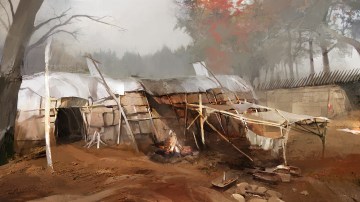About one year into the making of Assassin’s Creed III, the team at Ubisoft Montreal realized they needed help with their protagonist.
Ubisoft had the concept for a half-Mohawk, half-British assassin named Connor, who would fit the role of an outsider during the game’s American Revolution setting. But the last thing they wanted was a collection of clichés and stereotypes, so they began digging into the intricacies of Mohawk culture to make Connor more authentic. On their own, that turned out to be too difficult.
The team was running into too many faux pas and factual errors, so around April of 2011, Ubisoft Montreal hired a Mohawk cultural consultant to be on call at all times. The team also worked with the Kahnawà:ke Mohawk community near Montreal and contracted some of its residents to help translate, sing and voice act for the game.
“There are people from all over the world on our team, but we’re very aware that we’re still pretty much a bunch of early-middle-aged white guys,” Alex Hutchinson, Assassin’s Creed III‘s creative director, said in an interview. “We didn’t want to make mistakes, even well-intentioned mistakes.”

Kanien’kehá:ka Onkwawén:na Raotitióhkwa Language and Cultural Center
The consultant, Thomas Deer of the Kanien’kehá:ka Onkwawén:na Raotitióhkwa Language and Cultural Center, helped steer Ubisoft Montreal away from errors. When the team asked about including ceremonial masks in the game, Deer warned them that any visual depiction of the sacred masks is considered offensive. He advised them on which types of clothing and jewelry to use and which types of spiritual music were off-limits. Even Connor’s name had to be cleared for use–in Mohawk culture, each name must be unique–and Ubisoft’s lawyers agreed not to trademark it.
“It seemed like they went above and beyond in trying to get the community involved,” Deer said in an interview, “and I don’t think it was really so much to cover their butts, just that they wanted to have a real, authentic product that stood up.”
That attention to detail isn’t always a given in video games, which like other media has been known to under-represent minorities, and to rely on clichés and stereotypes for non-white characters.
A 2009 study of games released between 2005 and 2006 found that the most popular games had a greater percentage of white male characters than even the general U.S. population, and that Native Americans and Hispanic main characters were nonexistent. A content analysis of games from roughly the same time period found that minority male characters were portrayed as more aggressive than whites, and were often relegated to athletic or violent roles. They were seldom shown to operate computers or serve in the military.
Fielding Graduate University professor Karen Dill, who co-authored the latter study, said those types of depictions can be damaging. Although people may think they can recognize stereotypes in games and separate them from reality, Dill said, studies show that people tend to base their perceptions on media, especially when they don’t have much interaction with minorities.
“We don’t have a switch in our heads that says ‘real or unreal’ like we think we do,” Dill said in an interview.
Native American video game characters are particularly rare. And when they do appear–as with characters like Nightwolf from Mortal Kombat or Tal’Set from Turok: Dinosaur Hunter–they’re often boiled down to generic, spiritual people. Nuances in the culture are lost.

Mohawk village concept art, courtesy of Ubisoft
Deer said those generalizations are what bother him most, and he’s witnessed the effects. Many visitors to the cultural center, for instance, are surprised to see that Mohawks didn’t live in tee-pees, when they in fact lived in longhouses.
“Each individual indigenous nation in Canada and the United States is very different from one another, and I think mainstream society paints us in one brush,” he said.
Assassin’s Creed III‘s Connor doesn’t fall into that trap, and although Deer said he was worried about how the Mohawk community would react to the idea of a half-Native, ax-wielding assassin, he said their concerns faded as Ubisoft came into the community. (Deer notes, however, that he hasn’t actually seen the game, which launches on October 30. “I do have to say that I’ll only really know, once the game comes out, if they listened to me,” he said with a laugh.)
Without revealing any major plot details, Ubisoft’s Hutchinson also said it helps that Connor isn’t solely defined by his heritage. “I think that’s what attracted a lot of the groups to work with us. We had this idea that we’re just going to have a character, he’s a real character, he’s part of a 30-hour story, and you follow his whole life–and he’s also Native American,” he said. “It’s not a cardboard cutout.”
As for whether video games as whole can do better with portraying minorities, Hutchinson sees signs of improvement, such as the introduction of female heroes and another black squad member in 2011’s Gears of War 3. But he also said game developers could be more ambitious, and don’t need to rely so much on white males for mass appeal.
“I think they’re missing out on some fascinating stories and some fascinating opportunities by constraining themselves,” he said.
Dustin Clingman, Executive Director of the International Game Developers Association, is optimistic for improvement, though he admits the industry has “a long way to go.” He’s seen more diversity among game developers, which may lead to a broader cultural palette in the games they create, and he thinks audiences are demanding that.
“I think they’re hungry for more sophisticated stories,” Clingman said, “and that gives designers and writers the opportunity to take advantage of that and create a more diverse cast of characters.”

